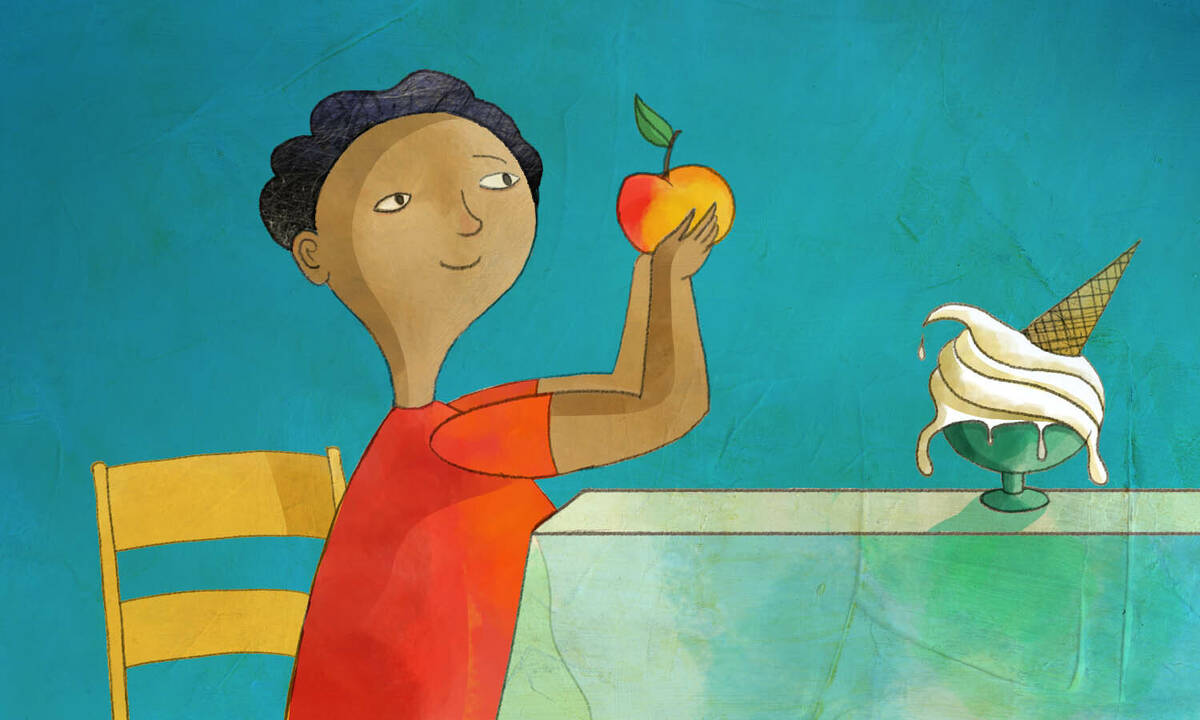Marketing Jul 3, 2024
Want Your Kids to Choose Healthy Foods? Here Are Some Research-Backed Tips.
First, stop demanding that they choose healthy foods!

Yevgenia Nayberg
If you can still recall the commercial jingles for your favorite childhood treats, you are probably aware that food marketers really know how to reach children. But whether or not you can trace a lifelong craving for marshmallow-laden Lucky Charms cereal to the television commercials of our youth (“They’re magically delicious!”), it’s clear that those messages are powerful.
It is possible, though, that some of those same marketing tactics can be harnessed to empower children to make better choices, says Michal Maimaran, a professor of marketing at the Kellogg School. Creating good eating habits is a long-term process that involves building a healthy relationship with food, day by day, meal by meal. Parents should know that even if they win the week, they’re still playing a long game.
Marketers know that framing matters in how kids make choices. So, for example, presenting decisions as simultaneous (selecting a number of products at one time) or sequential (selecting one product at a time each day) makes a difference in what people end up choosing. This works for children too: asking them to simultaneously pick out snacks for the whole week will lead them to choose a wider variety of healthier options.
Here, Maimaran, and her coauthor, Margaret Echelbarger of Stony Brook University, offer parents and caregivers insights from marketing research that they can put into practice at the kitchen table and beyond.
Focus on liking more than choosing
Parents often fixate on whether their kid ultimately makes a healthy choice. But there could be a more effective way to frame these decisions, says Maimaran. She suggests shifting the focus from getting kids to choose healthy options to instead building a liking for healthier foods through repeated exposure.
In other words, parents should reset their expectations. If they are hoping that a small child will always choose carrots over crackers, they’ll inevitably be disappointed, but, bit by bit, attitudinal change—letting the child gradually learn to like carrots and consider them as a viable option—can eventually lead to the desired outcome.
“You cannot expect a six-year-old to choose the broccoli every time over the mac and cheese,” she says. “It’s just not realistic. But by exposing them to broccoli every now and then, it will become part of their consideration set.”
Indeed, parents should recognize that helping a child learn to like a food, or even to accept it as an option, counts as meaningful progress, even if the results are not immediately apparent or measurable.
“It is important to realize that liking also matters,” she says. “If we are able to change the attitude of a child towards healthier options, then maybe long term, we will see them choosing the healthier options more frequently.”
Build kids’ muscles for self-control while you still have (some) control
A child who is only ever served carrots and broccoli at home will never learn how to develop the self-restraint they must exercise when they inevitably venture into the wide world of pie, cake, and ice cream. This means parents should provide children with opportunities to exert self-control, so they can gradually build that muscle.
“If we never give them the choice between the healthy and the unhealthy option, and always impose the healthy options, they are not going to establish healthy eating habits of their own,” Maimaran says.
“You cannot expect a six-year-old to choose the broccoli every time over the mac and cheese. It’s just not realistic. But by exposing them to broccoli every now and then, it will become part of their consideration set.”
—
Michal Maimaran
This muscle takes time to strengthen, meaning that this process may entail occasionally watching your child eat an entire plate of cookies while they are still developing their capacity for self-control. “We can think of it as safely failing,” she says. But she points to research showing that placing limits on the amounts of food kids eat can backfire, making kids want to eat more of it. Surprisingly, this finding holds even when the verboten food is a healthy one—although, of course, parents more often place limits on the consumption of unhealthy food (“Just one cookie!”).
“Instead, if kids can learn to control the consumption themselves, they’ll be able to better do it independently,” she says, which is especially important as they get older and have more chances to make food choices away from their parents.
Understand the influences kids are under
If you thought those television jingles that came on between cartoons were pretty darn effective (or at least catchy), consider today’s online advertising landscape, which is far more targeted and personalized.
Any time children spend online has the potential to expose them to advertising tailored to the content they are viewing, says Maimaran. Combine this with offline influences such as parents, teachers, siblings, and peers, and kids can be psychologically “primed” many times a day through exposure to different images and messages about food, weight, health, and other related topics.
“In children’s social worlds, both online and offline, they’re exposed to hundreds of those primes, especially when they scroll online,” she says. “And those social-media channels know how to customize the content those children are viewing.”
Since parents can’t exercise total control over what their children view online, any more than they can control every calorie that goes into their mouths, Maimaran advises them to communicate with children about their social-media use, as well as encourage self-control in how much time they spend online.
“Parents should recognize that this is a part of their life, and the kids want it to be a part of their life,” Maimaran says. By having open conversations, parents can explain how the economy of social media works and help their children think more critically about what they are consuming online.
Mamairan suggests teaching children to ask what it means to be on social media and what motivates influencers’ messaging. Parents can point out that an influencer might not be promoting a product out of genuine concern for their followers’ health or well-being, but because a company has sponsored them.
“Explain that these people are trying to sell you something that may not be beneficial for you,” she says. “Parents want to have an open conversation with their kids where they ask them: What social media influencers do you want to follow? What do you post? What do you view? This can help you understand that those posts may not be credible, that they are trying to trick you to do something.”
Anna Sussman is a writer based in New York.



